Business
Claire’s was glitz ‘heaven’ for kids before Shein and TikTok came along
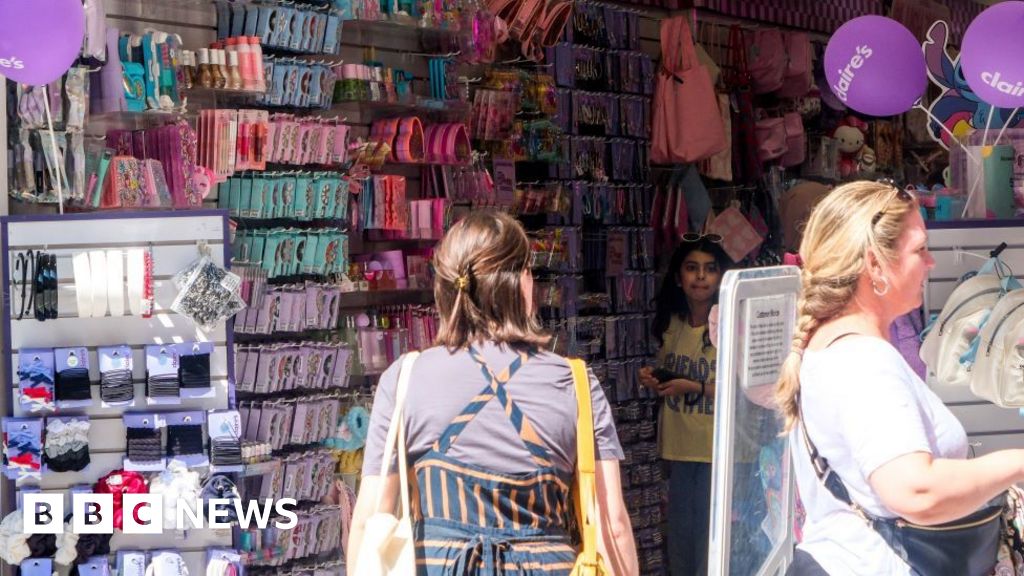
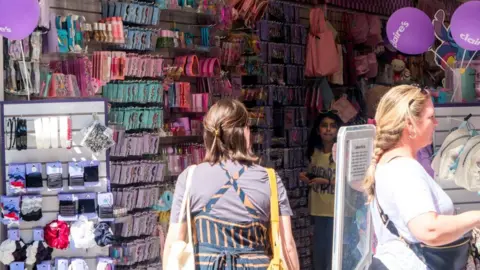 Matthew Chattle/Future Publishing via Getty Images
Matthew Chattle/Future Publishing via Getty ImagesFor Beth Searby, a Saturday as a teenager wasn’t complete without going to Claire’s with her friend.
But that tweenage rite of passage looks uncertain as the future of the chain hangs in the balance.
Beth and her friends would use their pocket money in the late noughties to buy magnetic earrings, badges and toe rings from the accessories brand.
“You never went home empty-handed,” says Beth, now 30.
Shopping there was like an “analogue Temu,” she says.
“You could go in with your bits of change that you had left from buying your McDonald’s or your Burger King and you could pick up a pair of earrings or a necklace or a badge to put on your school bag and you’d be spending 50p, £1, £2.”
 Beth Searby
Beth SearbyClaire’s has appointed administrators in the UK and Ireland after battling with falling sales and high competition.
It said its 278 shops in the UK and 28 in Ireland would continue trading while it considered “the best possible path forward”, but it’s stopped online sales.
Originally a US brand, Claire’s opened its first UK store in the mid-90s and quickly became a mainstay among tweens who flocked there for affordable hair ties, glittery butterfly clips, matching friendship necklaces and lip gloss.
“It was the ultimate shop for young people,” says Ella Clancy, 29.
She remembers using her pocket money to buy earrings, scrunchies and Lip Smacker lip balms from Claire’s as a teenager.
Particularly memorable are the so-called “nerd glasses” she and her friends got there – glasses with chunky, dark frames and no prescription.
The shops were always “super pink and colourful and girly,” she says.
“When you’re a little girl, it’s sort of like heaven,” says Vianne Tinsley-Gardener, 23.
She would go to the Claire’s stores in Braintree, Essex, to buy keyrings, earrings and stationery.
The shops were full of “unique little knick-knacks”, she says.
Its lucky dips bags – where you didn’t know what you were getting – and multibuy offers like its five items for £10 deal turned shopping there into a treasure hunt and catered to tweens’ budgets.
Claire’s was a staple for young people getting their ears pierced, too – and it often had special deals.
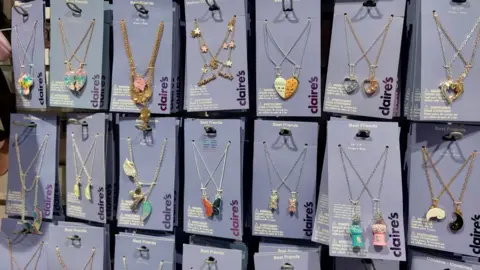 Grace Dean/BBC
Grace Dean/BBCBut many Claire’s shoppers found that some point during their time at secondary school, the brand just stopped being cool.
They turned to places like Accessorize, Topshop and Primark instead.
This was the case for Ceara Silvano, 23. She remembers it became too “kiddish” when she was about 13 and she started shopping at Primark instead.
“You do just grow out of stuff like that,” Ceara says – though she still returned later to have her ears pierced at Claire’s.
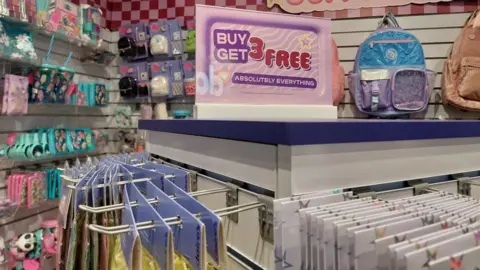 Grace Dean/BBC
Grace Dean/BBCAl Thomann loved Claire’s when they were younger because of its use of bright colours, glitter and floral designs.
But as they grew up, they too started to see the brand as “childish” and stopped shopping there.
“You start to feel like you’re a young adult, and all around me, most of the adults were not shopping at Claire’s,” Al, now 25, says.
“Aspiring to be an adult meant rejecting that sort of childlike, colourful, rainbow, unicorn whimsy.”
How young people shop is changing
Back in the 2000s and 2010s, young people bought things because they liked them, rather than because they were trendy, says Constance Richardson, who owns the personal styling business By Constance Rose.
But thanks to rising use of social media, young people are keeping up-to-date with what’s stylish online.
“Shein can spot a trend on TikTok and have that live within days, often for much less money” than Claire’s, says Georgia Wright, a reporter at Retail Gazette.
Shein, a Chinese online fast-fashion giant, sells a huge range of items including clothes, accessories and stationery for low prices.
Claire’s, in comparison, doesn’t pounce on trends as quickly, Ms Wright says.
And it can’t compete on price, Miss Richardson says. “They’re still selling novelty products at a non-novelty price.”
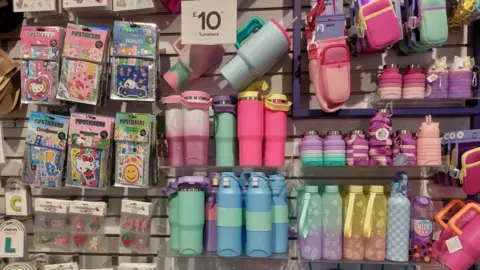 Grace Dean/BBC
Grace Dean/BBCAnother factor is that young people are often influenced by creators on social media who are much older than them – and don’t shop at Claire’s.
“Kids are growing up faster than ever,” says Ms Wright. “You’ve got 11 year olds with five-step skincare routines.”
At the other end of the spectrum to Shein, they’re turning to more premium brands like Sephora, Space NK and Astrid and Miyu, she says.
Claire’s “just doesn’t deliver the same excitement,” Ms Wright says.
 Al Thomann
Al ThomannBut the brand still holds a special place in many people’s hearts.
Ceara says she feels nostalgic about shopping at Claire’s and wishes she’d kept some items as mementoes.
Whenever Ella walks past Claire’s stores, “it brings a little smile to my face”.
And some people say they still enjoy shopping at the brand.
“As I started university and started thinking about my own sexuality and gender identity and how I wanted to present myself, the sort of items that Claire’s sold once again came back into my field of knowledge,” Al says.
“All of the really beautiful, very unique earrings and necklaces, bracelets, flower crowns, those kinds of things, were almost instruments to display my own identity in a way that was visible.”
Business
Private sector data: Over 2 lakh private companies closed in 5 years; govt flags monitoring for suspicious cases – The Times of India

NEW DELHI: The government on Monday said that over the past five years, more than two lakh private companies have been closed in India.According to data provided by Minister of State for Corporate Affairs Harsh Malhotra in a written reply to the Lok Sabha, a total of 2,04,268 private companies were shut down between 2020-21 and 2024-25 due to amalgamation, conversion, dissolution or being struck off from official records under the Companies Act, 2013.Regarding the rehabilitation of employees from these closed companies, the minister said there is currently no proposal before the government, as reported by PTI. In the same period, 1,85,350 companies were officially removed from government records, including 8,648 entities struck off till July 16 this fiscal year. Companies can be removed from records if they are inactive for long periods or voluntarily after fulfilling regulatory requirements.On queries about shell companies and their potential use in money laundering, Malhotra highlighted that the term “shell company” is not defined under the Companies Act, 2013. However, he added that whenever suspicious instances are reported, they are shared with other government agencies such as the Enforcement Directorate and the Income Tax Department for monitoring.A major push to remove inactive companies took place in 2022-23, when 82,125 companies were struck off during a strike-off drive by the corporate affairs ministry.The minister also highlighted the government’s broader policy to simplify and rationalize the tax system. “It is the stated policy of the government to gradually phase out exemptions and deductions while rationalising tax rates to create a simple, transparent, and equitable tax regime,” he said. He added that several reforms have been undertaken to promote investment and ease of doing business, including substantial reductions in corporate tax rates for existing and new domestic companies.
Business
Pakistan’s Textile Exports Reach Historic High in FY2025-26 – SUCH TV

Pakistan’s textile exports surged to $6.4 billion during the first four months of the 2025-26 fiscal year, marking the highest trade volume for the sector in this period.
According to the Pakistan Bureau of Statistics (PBS), value-added textile sectors were key contributors to the growth.
Knitwear exports reached $1.9 billion, while ready-made garments contributed $1.4 billion.
Significant increases were observed across several commodities: cotton yarn exports rose 7.74% to $238.9 million, and raw cotton exports jumped 100%, reaching $2.6 million from zero exports the previous year.
Other notable gains included tents, canvas, and tarpaulins, up 32.34% to $53.48 million, while ready-made garments increased 5.11% to $1.43 billion.
Exports of made-up textile articles, excluding towels and bedwear, rose 4.17%, totaling $274.75 million.
The report also mentioned that the growth in textile exports is a result of improved global demand and stability in the value of the Pakistani rupee.
Business
Peel Hunt cheers ‘positive steps’ in Budget to boost London market and investing

UK investment bank Peel Hunt has given some support to under-pressure Chancellor Rachel Reeves over last week’s Budget as it said efforts to boost the London market and invest in UK companies were “positive steps”.
Peel Hunt welcomed moves announced in the Budget, such as the stamp duty exemption for shares bought in newly listed firms on the London market and changes to Isa investing.
It comes as Ms Reeves has been forced to defend herself against claims she misled voters by talking up the scale of the fiscal challenge in the run-up to last week’s Budget, in which she announced £26 billion worth of tax rises.
Peel Hunt said: “Following a prolonged period of pre-Budget speculation, businesses and investors now have greater clarity from which they can start to plan.
“The key measures were generally well received by markets, particularly the creation of additional headroom against the Chancellor’s fiscal rules.
“Initiatives such as a stamp duty holiday on initial public offerings (IPOs) and adjustments to the Isa framework are intended to support UK capital markets and encourage investment in British companies.
“These developments, alongside the Entrepreneurship in the UK paper published simultaneously, represent positive steps toward enhancing the UK’s attractiveness for growth businesses and long-term investors.”
Ms Reeves last week announced a three-year stamp duty holiday on shares bought in new UK flotations as part of a raft of measures to boost investment in UK shares.
She also unveiled a change to the individual savings account (Isa) limit that lowers the cash element to £12,000 with the remaining £8,000 now redirected into stocks and shares.
But the Chancellor also revealed an unexpected increase in dividend tax, rising by 2% for basic and higher rate taxpayers next year, which experts have warned “undermines the drive to increase investing in Britain”.
Peel Hunt said the London IPO market had begun to revive in the autumn, although listings activity remained low during its first half to the end of September.
Firms that have listed in London over recent months include The Beauty Tech Group, small business lender Shawbrook and tinned tuna firm Princes.
Peel Hunt added that deal activity had “continued at pace” throughout its first half, with 60 transactions announced across the market during that time and 10 active bids for FTSE 350 companies, as at the end of September.
Half-year results for Peel Hunt showed pre-tax profits jumped to £11.5 million in the six months to September 30, up from £1.2 million a year earlier, as revenues lifted 38.3%.
Peel Hunt said its workforce has been cut by nearly 10% since the end of March under an ongoing savings drive, with full-year underlying fixed costs down by around £5 million.
Steven Fine, chief executive of Peel Hunt, said: “The second half has started strongly, with the group continuing to play leading roles across both mergers and acquisitions and equity capital markets mandates.”
-

 Sports1 week ago
Sports1 week agoWATCH: Ronaldo scores spectacular bicycle kick
-

 Entertainment1 week ago
Entertainment1 week agoWelcome to Derry’ episode 5 delivers shocking twist
-

 Politics1 week ago
Politics1 week agoWashington and Kyiv Stress Any Peace Deal Must Fully Respect Ukraine’s Sovereignty
-

 Business1 week ago
Business1 week agoKey economic data and trends that will shape Rachel Reeves’ Budget
-

 Politics1 week ago
Politics1 week ago53,000 Sikhs vote in Ottawa Khalistan Referendum amid Carney-Modi trade talks scrutiny
-

 Tech6 days ago
Tech6 days agoWake Up—the Best Black Friday Mattress Sales Are Here
-

 Fashion1 week ago
Fashion1 week agoCanada’s Lululemon unveils team Canada kit for Milano Cortina 2026
-

 Tech23 hours ago
Tech23 hours agoGet Your Steps In From Your Home Office With This Walking Pad—On Sale This Week







